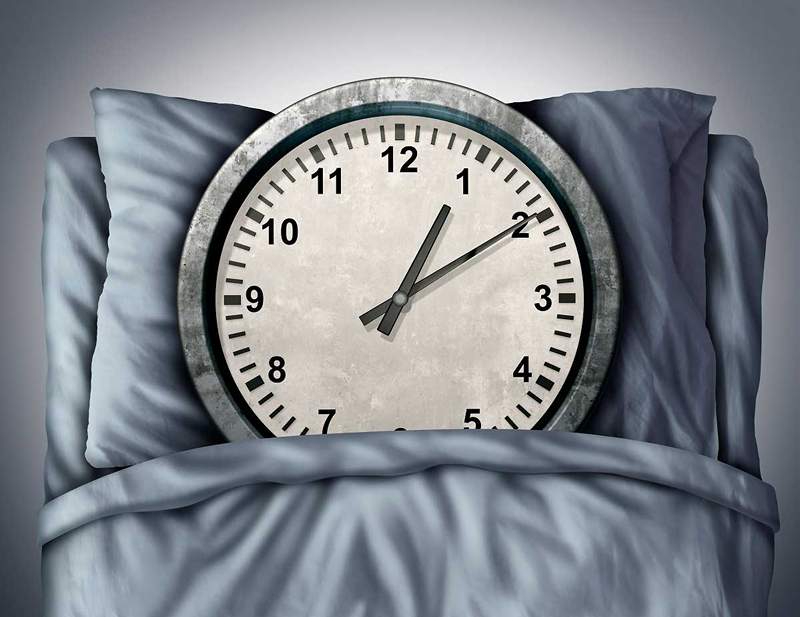The importance of sleeping and dreaming

- 1192
- 59
- Charles Fay
If the dream did not serve an absolutely vital function, it would be the greatest mistake ever made by evolution. Allan Rechtschaffen
As human beings we have many needs: hunger, contact, sex, thirst and the act of sleeping.
Dream, sleep, Enso, hallucinar, sleep, hallucination, lucid dreams, nightmares, sleep paralysis, night terrors, seem to be terms taken from the trunk of fantasy of the intangible, of the accessory: sometimes loaded with beautiful and sometimes very ugly events. However, in the melting pot of these behaviors they are all related to sleep and at the same time each of them are different.
Content
Toggle- What is the dream?
- What is the circadian rhythm
- Our internal biological clock
- The importance of sleeping and dreaming
- Parasomnias
- Some of the most common parasomnias
- Dysomnias (lack or excess sleep or dream of poor quality)
- Parasomnias (partial interruptions of brief and episodic sleep)
- Sleep disorders associated with medical or psychiatric processes
- Some of the most common parasomnias
- Sleep or dream, is it the same?
- The strategies to measure sleep
- Stages of sleep
- Consequences of not sleeping
- Consequences of not sleeping well
- Precautions to sleep well
- Sleep benefits healthily
- Bibliography
What is the dream?
The dream is far from being a uniform state in which we enter shortly after retiring to rest and from which we wake up. Dream is a multifaceted, schematized and complex activity. We all know from our own experience that the dream varies from a light state of drowsiness, of which it is easy to wake up, to the state of sleeping as a trunk, from which it is difficult to wake up (Santiago, Cider, Goethaals, Kavanaugh and Solomon, 1989).
It is not surprising the confusion that exists between sleeping (rest) and dreaming (repair or recovery), which for the common people is the same. And, most likely, from there those two great trends come to explain how to sleep or dream through two great theories. A behavior oriented that we have during the day and night cycle and another more as a homeostatic balance process: molecular (chemical and electrical) and hormonal.
- The essentials of Sleep Recovery Theories is that being awake alters, in some way, homeostasis (the internal physiological balance) of the organism, and it is necessary to sleep to restore it. So, Somnolence is triggered by a deviation from homeostasis caused by vigil And that the dream ends when homeostasis has been recovered.
- In the other part, the Circadian sleep theories They point out that this is not a reaction to the disturbing effect of being awake, but the result of an internal synchronization mechanism -that is, we beings beings humans are scheduled to sleep at night regardless of what happens to us in the day-. According to this, we have evolved to sleep at night because the dream protects us from accidents and predators (Pinel, 2007).
What is the circadian rhythm
The circadian term comes from the Latin Circa, "around", and ten "day". Circadian rhythms, such as the sleep-vigilia cycle, have a periodicity of approximately 24 hours, that is, one day.
Many species of animals have been identified have an internal clock that govern every day of their lives. This clock has been perfected for many years of evolution and is our guide or our internal light. So listening to the body is an excellent way to get in touch with this clock to keep us healthier. If we act against him, we will surely suffer its consequences.
This main biological clock is located bilaterally in the supraquiasmatic nucleus of the hypothalamus previous and obviously has reciprocal projections with the neural centers that regulate sleep and vigil.
 Chiropraxia: 11 benefits
Chiropraxia: 11 benefits Our internal biological clock
Chronobiologists are researchers who specialize in the study of internal watches. Although we all have an internal clock, it does not work the same for everyone. Some have a cycle that operates in 22 hours, while in others it operates in a 25 hours. We call the people with these extremes.
LOONDRAS ARE THOSE WHO LIKE EARGEAN WITH MOST BIOLOGICAL WATCHES.
Those who have a longer biological clock tend to lag and their behavior resembles that of the owl (Redolar, 2015; BBC, 2011).
This is the reason why there are people who feel more comfortable doing their activities earlier (Alondras) or who like to work more at night (owls). The internal biological clock is also affected by our age. When we are babies and children we go to bed early, teenagers with a physiologically more altered biological clock are ready late and get up late, but when we reach fifty we lay down like when we were the age of ten years.
The different theories lead to different interpretations, giving rise to controversies and polarizations. However, taking into account that knowledge is power, let's see an approach to the benefits of sleeping and dreaming in the short and long term.
The importance of sleeping and dreaming
The criteria taken by a researcher to choose an analysis topic are very varied and one of those routes is defined by the time invested in performing an activity, if this is little or a lot.
It is supposed to remember what happens while one sleeps, most people tend to consider sleep as a state of consciousness, rather than as a behavior (Redolar, 2015). However, this does not happen When we analyze lucid dreams, where the sleeping can have control of the scenes and actions that have elapsed during sleep, still a state in that dreamlike state.
Let's go to extremes!. Suppose sleeping a lot brings health benefits: why not spend life sleeping?. And, suppose to sleep little helps us to carry out more activities during the vigil time: why not sleep very little?. There are also those who sleep more, even if they want to avoid it and there are those who sleep less and would like to sleep more.
Having a biological internal clock makes us sleep on a certain time, but also among human beings, without counting sleep disorders, we need an average time to do so.
In the world of mammals there are those who sleep little and who sleeps a lot comparatively with respect to the human being in one day: the giant lazy bear (20 hours), the giant armadillo (18 hours), the cat (14 hours), the jaguar (10 hours), the chimpanzee (9 hours), the human being, the rabbit and the pig (8 hours), the cow, the goat, the elephant, the donkey and the sheep (3 hours) and the deer and the horse (2 hours) (Pinel, 2007).
We spend a third of our life sleeping and from that third 20% dreaming. And yet, we hardly know anything about dreams. The truth we have lost a lot of time interpreting dreams. Now neuroscience is discovering two fundamental things of dreams:
1) that serve to reorder the memoirs, the memories accumulated during the day and
2) The most important are a kind of healthy hallucination that serves to study the brain (Punset, 2015).
That is, a 60 -year -old person will have slept 18 years of his life and more than 3 years dreaming.
Sleep is not a simple and partial behavior, it has a multiple function and holistic for the proper functioning of the human being. If someone did not sleep, he would end up dying.
It influences the activity of different areas, as mentioned by Stickgold (2015), director of the Sleep Center and the cognition of the Beth Diaconist Medical Center in Israel in Boston, all of them interconnected:
- Biological and physiological: maintains the balance of the immune system, and also in the elimination of brain toxins,
- Endocrine: regulating the correct hormonal balance,
- Psychological: Maintain mental and emotional health,
- Cognitive: contributing to learning and memory.
However, when we talk about the dream, not all the time it is as the happy stories or endings of the night say, they are sweet dreams. There are more than 100 sleep -related alterations and some of them are mentioned.

Parasomnias
Parasomnias are alterations or behavioral disorders related to sleep. They are brief or episodic type. They usually occur in transitions between sleep and vigil, or vice versa, or in certain sleep phases.
The International Classification of Sleep Disorders (International Classification of Sleep Disorders or ICSD) distinguishes three large groups of sleep diseases: dysomnias, parasomnias (pathological disorders that happen during sleep) and psychiatric disorders of sleep.
Some of the most common parasomnias
Dysomnias (lack or excess sleep or dream of poor quality)
- Intrinsic sleep disorders: Psychophysiological insomnia, narcolepsy
- Sleep extrinsic disorders: Sleep environmental, nightlife or drink, sleep disorders secondary alcohol, drugs or drugs.
- Sleeping circadian rhythm disorders: Quick Time Zone Syndrome, Night Workers Sleep Disorder.
Parasomnias (partial interruptions of brief and episodic sleep)
- Awakening disorders: Speaizbery and night terrors.
- Dream-Vigilia Transition Disorders: Night speaking disorders and leg cramps.
- Parasomnias associated with REM Dream: Nightmares, sleep paralysis, sleep -related erections
Sleep disorders associated with medical or psychiatric processes
- Depression
- Parkinson's disease
- Mortal family insomnia
- Sleep -related asthma
- Sleep -related gastric reflux (Wikipedia, 2015).
And, is that sleeping and dreaming is not the same, but they are part of the same cell repair and balance process in body and mind homeostasis. Or as we saw, they are part of the cycles of day and night.
 Psychological insomnia, what is it
Psychological insomnia, what is it Sleep or dream, is it the same?
First, let's see that these are two different structural and functionally conceptual behaviors, but that they are part of the same behavior and sometimes talk about them as if it were the same thing.
- Sleep: Being, entering or entering the periodic state of rest, during which the senses and voluntary movements are suspended or inactive (Larousse, 2003). Sleep It implies being in a state of rest in which any conscious activity and any voluntary movement (definitionabc, 2017) are fully suspended.
- Dream: Perceive or imagine things that seem real, while falling asleep. Represent in mind as possible or certain things that are not. Wish. Yearn or desire. Being a distracted person or waiting unlikely or difficult things, is always in the clouds, dreaming awake (Thefreedictionary, 2017).
- Dream: Mental state that occurs when it falls asleep and is characterized by a display of sensory, motor, emotional and cognitive experiences. Dreams occur more often, but not exclusively, during periods of Mor sleep (APA, 2010).

It is interesting to review how these two concepts come to be taken as synonyms both in everyday life and in some more specialized sources. If sleeping behavior is mentioned, we immediately talk about the benefits or damages of not achieving a deep sleep and the reader must understand that it is the same. If not, you sleep well, you will have: benefits and losses!. It is hardly possible to differentiate both steps from this complex behavior, which we are knowing fortunately more and more.
The act of sleep, an unconscious polysemic cultural function is assigned and has many implications and associations:
- With death: "He fell asleep and woke up anymore," my pet was so sick that I preferred that the veterinarian slept it ",
- With the absence: "Rita did not sleep at home"
- With conjugal or couple life: "Rubén sleeps for a year with Lilia",
- With responsibility and oblivion: Victor fell asleep and passed his date to register .. ,
- With accidents: "Yesterday's accident was because the driver fell asleep at the wheel",
- With boredom: "The class was so boring that I was sleeping",
- With the effects of anesthesia in medicine: "In the operation they slept from the waist down",
- With the consequences of accidents: "Now your left hand is asleep",
- With circadian habits: "It is impossible that he falls asleep early",
- With the functioning of our biological clock: "He sleeps early and gets up early, it's an all,
- With the disease: "It is depressed and spends sleeping",
- With stress chronic: "He has so much work that he hardly sleeps",
- With exaggerated confidence and the forecast of the future: "He fell asleep in his laurels and that's why he lost competition".
The list continues, and we are unable to distinguish that they are different and in turn complementary phases. Then, sleeping, goes beyond resting and entering a period of voluntary movement inactivity.
Sleep is a basic need for human beings and many other living beings. And, scientists divide it into phases, each with manifestations of brain activity, related to specific areas of the brain, as well as electrical, molecular and hormonal activity. Then, we will understand that sleeping implies and dreaming is divided into complex and dynamic stages.
In the same way when we talk about dreaming, in the cultural and colloquial part you have this same polysemic function, but denotes more specific and subjective elements, typical of each dreamer, not only in the field of its environment, but also of its personality and personality and His state of physical and mental health. Relates to:
- The imagination: You dream awake and you make castles in the air
- Sleep disorders: Nightmares, insomnia, night terrors or sleepwalking. This work is a nightmare.
- Oxytocin production after having sex, in men and women, makes them fell asleep because it produces them Postcoital narcolepsia.
- See the future in the equivalent of having lucid dreams. "Things were as I dreamed them".
- The phases of sleep: I have the dream very light, I fell asleep and when the alarm sounded, I was dreaming that I was in a forest.
- I couldn't wake up, I heard everything around and felt that the dead got, It is the parasomnia called sleep paralysis.
The strategies to measure sleep
The sleep laboratories, using the combination of certain electrophysiological techniques called jointly polisomnography (PSG), have been able to observe that while one sleeps there is a lot of physiological changes that define very different behavioral states. The PSG consists of the simultaneous record of various techniques ..
- Electroencephalogram (EEG): by electrodes located in the scalp in central and occipital areas.
- Electromyogram (EMG): by electrodes located on the chin to detect muscle activity.
- Electrooculoogram (EOG): by electrodes located in the outer song of the eyes that record ocular movements.
In addition, electrodes and transducers can be used to record heart rate, breathing, blood oxygen saturation, penile bursence, or limb movements. The graphical representation of the dream in a human being is called hypnogram. In it you can see the sleep structure: the duration of the sleep and the number of awakenings or episodes of vigil during the night (Redolar, 2015).
Stages of sleep
The dream is a singular behavior in which two different states are given:
- REM Dream (Rapid Eye Movement, Rem), It is a very active dream where the eyes move very quickly under the eyelids, this is when we dream and we have nightmares and
- Non REM DREAM, It is when the brain is calmer, the muscles relax, we segregate more hormones, brain waves are increasingly slow and the heart beats slower. It is the time when the body is also repaired. It is a deep sleep and there may be snoring, sleepwalking, soliloquies (speaking alone). (Punset, 2014).
Both states of sleep are very different from each other and at the same time in the state of vigil. And, they alternate during a night. Each cycle lasts approximately 90 minutes and includes a REM dream of about 20 to 30 minutes. So, in an 8 -hour dream approximately four or five periods of Remi sleep will be presented.
Researchers have identified four different stages in sleep, each with their specific characteristics. Each of them seems to follow a depth continuum of sleep:
- Stage 1: The lightest level of sleep, It takes place as soon as we begin to fall asleep. The EEG shows irregular waves of a relatively low voltage. It is characterized by the appearance of Theta Activity (3.5 to 7.5 Hz), which indicates that the discharge of the neurons of the cerebral cortex is becoming more and more.
- Stage 2: A deeper level of sleep, It is identified by the appearance of very fast waves from time to time. These sudden appearances of fast waves are known as sleeping spindles, because they remember the wrapped thread around a sewing spindle.
- Stage 3: Mark a transition from a relatively light dream to the very deep sleep. The EEG begins to show periods with slow voltage waves. These are known as Delta waves.
- Stage 4: It is the deepest level of sleep. Delta waves appear almost constantly in the EEG. Phases 3 and 4 in humans are usually grouped and calling a dream of slow waves (Sun) (Santiago, Cider, Goethals, Kavanaugh and Solomon, 1989; Redolar, 2015).
If we manage to reach stage 4, we can say that we reach an optimal and 100% repair level. However, when this is not achieved, there may be from light consequences, to extremes such as death.
 Baby's dream: habits and sleep disorders
Baby's dream: habits and sleep disorders Consequences of not sleeping
If a person suffers from insomnia (due to sleep deprivation or due to the disease of mortal family insomnia or death from prion disease) for months he will end up dying.
Consequences of not sleeping well
- Only a complete or partial insomnia night alters different bodily functions, such as hormonal activity and infections protection.
- Insomnia favors weight gain. Increase Grelina levels (appet stimulating hormone). And, a tendency to suffer from obesity.
- There is a relationship between sleep restriction and type 2 diabetes and decreases body sensitivity to insulin.
- Apnea can cause snoring, gasps and other breathing alterations.
- If you do not sleep well, we end up remembering much more the negative events than the positives, generating a biased and depressing memory, of everyday life.
- Do not sleep well negatively affects the functions of the central nervous system, impacting memory, emotions and appetite regulation.
- And, also causes greater circumstances and contributes to other psychiatric disorders.
- Sleeping little is a wrong strategy to face the demands of everyday life.
- Who does not sleep enough, runs the risk of ending - appropriate very tired - sick, obese, dismembered and deeply depressed (Stickgold, 2015).
Precautions to sleep well
- Expose yourself to sunlight during the day.
- Do physical activity of aerobic preference.
- Do not have dinner too much and avoid energy drinks, with a lot of sugar or even alcoholic.
- Avoid liquid consumption three hours before going to sleep.
- Have a fixed routine to sleep at least 7 hours a day.
- Elsa Punset proposes to sleep well: set a schedule to go to bed and another to get up, vigorous aerobic exercise (walking, running, dance, etc.) The time does not matter, take a hot shower before bedtime and leave worries for tomorrow (Punset, 2014).
 Kratom, benefits and side effects
Kratom, benefits and side effects Sleep benefits healthily
- Have a radiant complexion.
- Our immune system is strengthened.
- It is possible to lose weight if it is well rested.
- If you slept well you will get up more optimistic and happy (definitionabc, 2017).
- Heals the drowsiness.
- Influences the optimal functioning of numerous biological processes.
- Improves the performance of the immune system, the correct hormonal balance, mental and emotional health, learning and memory, and also in the elimination of brain toxins. Although the physiological mechanism by which sleep influences mental health is unknown, it is suspected that it has a lot to do with the transformation of daily experiences into memories. It has been proven thus, to sleep after learning activities facilitates stabilization, consolidation, integration and selective analysis of new memories. The dream thus controls what we remember and how we remember it. The dream reinforces all those elements that it considers valuable. Reinforced memory in sleep serves to strengthen the future, not the past (Stickgold, 2015).
- In this way, the colloquial statement to consult things with the pillow before making an important decision in life is true.
Bibliography
- APA (2010) Concise Psychology Dictionary, Editorial El Manual Moderno, Mexico.
- BBC (2011). The human body clock, consulted on May 31, 2017, in network: https: // www.Youtube.com/watch?v = pdqesfate1m
- Definitionabc (2107) Definition of sleeping, consulted on May 29, 2017, in network: https: // www.DEFINITIONABC.com/general/sleep.PHP
- Pinel j. (2007). Biopsychology, Editorial Pearson Addison Wesley, Madrid.
- Punset e. (2014) Sleep tips well, consulted on May 31, 2017, in network: https: // www.Youtube.com/watch?v = wl6oqfe-x4
- Punset e. (2015) Networks, nightmares are not dreams, consulate on May 28, 2017, in network: https: // www.Youtube.com/watch?v = g5dr_ahpsek
- Redolar d. (2015). Cognitive Neuroscience, Pan American Medical Editorial, Madrid
- Santiago Z., Cider a., Goethaals g., Kavanaugh r. and Solomon p. (1989). Psychology, Editorial Scott, Foresman and Company, Glenview, Illinois.
- Stickgold R. (2015) Benefits of sleep (how it influences nervous, immune and endocrine systems), the vital functions of sleep, research and science magazine, number 471, Barcelona.
- Thefreedictionary (2017) Definition of Dreaming, consulted on May 31, 2017, in Red: https: // es.the free dictionary.com/so%c3%b1ar
- Wikipedia (2015) International Classification of Sleep Disorders, consulted on May 27, 2017, in Red: https: // es.Wikipedia.org/wiki/classification%c3%b3n_internacional_de_los_tters_del_sue%c3%b1o

